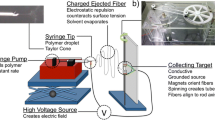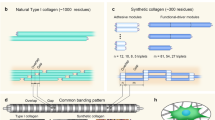Abstract
Collagen is the most abundant protein present in the human body and found in connective tissues, bone, and tendon. It is also known as a natural resource for healing damaged skin tissues [1]. In this study, under specific microenvironment conditions, mimetic collagen gels were successfully formed synthetically from reconstituted Bovine type I collagen monomers. This was achieved by controlling ionic strength, temperature and pH, allowing fibrils with native mimetic D periodic banding structure to assemble spontaneously within the gels. In addition, by providing appropriate aging temperatures and times, mature collagen fibril growth is also realized in the gels in vitro. Mimetic gels were subsequently formed into fibers through a wet-spinning process. These spun fibers were found to preserve the native mimetic D periodic banding and fibrillar structure formed in the initial gels. As a result, the synthetic fibers resemble native tendon. Here structural development within the gel samples and fibers as a function of processing was analyzed by scanning electron microscopy (SEM). Results in this study also show a potentially new route for the fabrication of synthetic collagen fibers mimicking tendon, which may find applications as engineered tissues or scaffolding materials.
Similar content being viewed by others
References
J. S. Boateng, K. H. Matthews, H. N. E. Stevens and G. M. Eccleston, J. Pharm. Sci. 97 (8), 2892–2923 (2008).
K. L. Goh, J. R. Meakin, R. M. Aspden and D. W. Hukins, Proceedings. Biological sciences / The Royal Society 272 (1575), 1979–1983 (2005).
V. C. Hascall and K. E. Kuettner, The Many Faces of Osteoarthritis. (Birkhäuser Basel, 2012), pp. 121–124.
J. M. Caves, V. A. Kumar, J. Wen, W. Cui, A. Martinez, R. Apkarian, J. E. Coats, K. Berland and E. L. Chaikof, Journal of Biomedical Materials Research Part B: Applied Biomaterials 93 (1), 24–38 (2010).
D. I. Zeugolis, S. T. Khew, E. S. Y. Yew, A. K. Ekaputra, Y. W. Tong, L.-Y. L. Yung, D. W. Hutmacher, C. Sheppard and M. Raghunath, Biomaterials 29 (15), 2293–2305 (2008).
P. P. Provenzano and R. Vanderby Jr, Matrix Biology 25 (2), 71–84 (2006).
D. I. Zeugolis, R. G. Paul and G. Attenburrow, Acta Biomaterialia 4 (6), 1646–1656 (2008).
M. C. Wang, G. D. Pins and F. H. Silver, Biomaterials 15 (7), 507–512 (1994).
J. P. R. O. Orgel, A. Miller, T. C. Irving, R. F. Fischetti, A. P. Hammersley and T. J. Wess, Structure 9 (11), 1061–1069 (2001).
L. Bozec, G. van der Heijden and M. Horton, Biophysical Journal 92 (1), 70–75 (2007).
M.-M. Giraud-Guille, E. Belamie, G. Mosser, C. Helary, F. Gobeaux and S. Vigier, Comptes Rendus Chimie 11 (3), 245–252 (2008).
D. Kaplan and K. McGrath, Protein-Based Materials. (Birkhäuser Boston, 2012), pp. 283–285.
Author information
Authors and Affiliations
Rights and permissions
About this article
Cite this article
Aishanjiang, D., Green, E.C., Li, H. et al. Advances Toward Forming Synthetic Mimetic Tendon. MRS Advances 1, 1283–1288 (2016). https://doi.org/10.1557/adv.2016.252
Published:
Issue Date:
DOI: https://doi.org/10.1557/adv.2016.252




